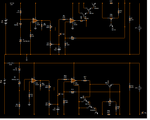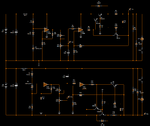Scolioza
Member level 1
Hello all.
I want to build a double power supply with current limitter only with opamps and transistors. After i read a lot i decided to make my own design (to put in practice what i have learnt by myself ). I simulated the design and it seems to work ok but i do not have experience so i am asking for help in finding any erros or improvements.
I omited the rectifier and filtering part and as a load i used a light bulb .
Thank you in advance
I want to build a double power supply with current limitter only with opamps and transistors. After i read a lot i decided to make my own design (to put in practice what i have learnt by myself ). I simulated the design and it seems to work ok but i do not have experience so i am asking for help in finding any erros or improvements.
I omited the rectifier and filtering part and as a load i used a light bulb .
Thank you in advance

